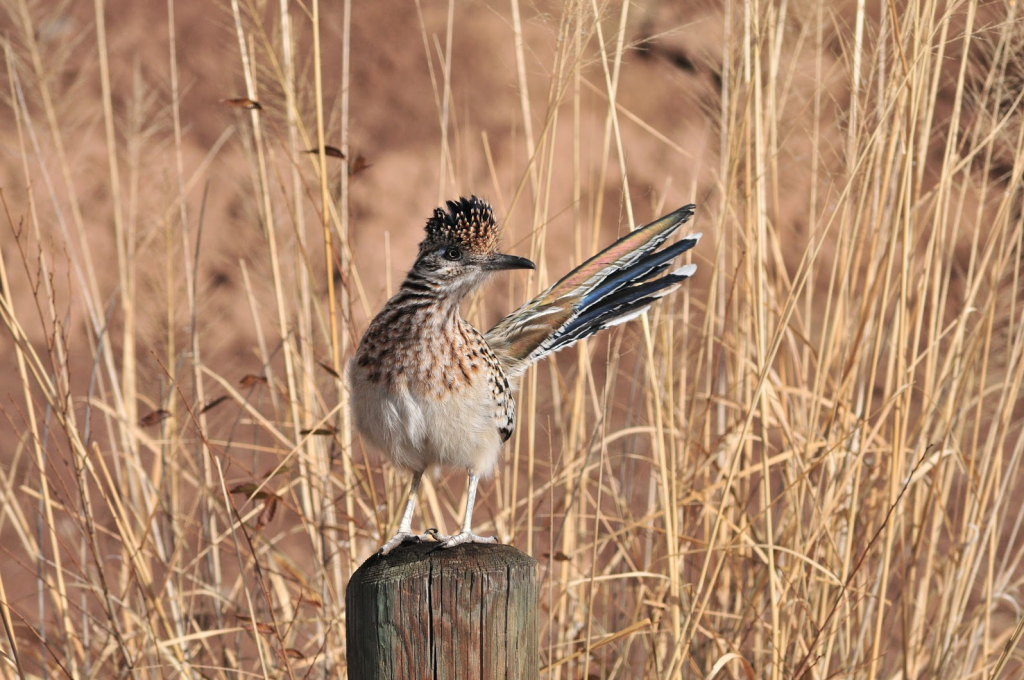[vc_row][vc_column width=”1/1″][text_output]
ANSWERED QUESTION
In New Mexico, roadrunners are more than cartoon character
As part of our Curious New Mexico project, Russell Yazzie asked if roadrunners can fly. As part of the work to answer that question, student reporters Jocelyn Moya, Pauly Dentclaw, Sam Kerwin and Paul Kelly delved into the bird’s cultural significance, its diet and lifespan.

The roadrunner has been the state bird of New Mexico for more than 65 years, but the bird’s culture significance has been a part of the state for much longer. Photo courtesy of Tom Kennedy / UNM Biology Department
The roadrunner plays a big star in the comical Looney Tunes duo with Wile E. Coyote, but the bird has been important to New Mexicans and their ancestors far beyond the cartoon series.
The Greater Roadrunner, or Geococcyx Californianus, has been New Mexico’s state bird for more than 65 years, but details about the nature of the roadrunner and it’s cultural significance are still unknown to many residents.
Cultural significance
New Mexico is home to 23 different Native nations, some of which feature the roadrunner in their traditional stories. Sunny Dooley, an internationally known Navajo storyteller, said the roadrunner – or naatsédlózii – is a messenger bird and brings healing.
“His feathers are used in a number of ceremonies to heal a number of ailments,” Dooley said in an interview. She estimates that three to five of the traditional Navajo ceremonies use the feathers of the roadrunner.
The roadrunner also has a song series in the Navajo shoe games and a small part in the Navajo Creation Story, Dooley said.
Stories are also told of the roadrunner being a leader or king in the Apache Folklore, Leader of the Birds and Mayan Legend, How the King of Birds was Chosen.
Lifespan
The roadrunner is at home in the Southwest, in part because it is well adapted to desert living.
“Out here in the desert southwest, we have lots of shrubs which are good for them,” said Tom Kennedy, a lecturer in the University of New Mexico’s Biology Department. “They like to run around and it’s open, it’s not dense forest, so that’s why they’re here.”
Bird enthusiasts like Kennedy use a technique called banding in order to conduct bird research.
“We catch them in nets and stick bands on them to collect how much they weigh, we try to sex them, age them and then we release them so we can track them over time and get life history data,” Kennedy said.
As part of Kennedy’s research, he determines the lifespan of roadrunner is about seven years.
Diet
The roadrunner eats prey that are low to the ground such as insects, birds, lizards, snakes, gophers, and mice.
“They will eat anything they can fit down their gullet,” said Andy Johnson, the collection manager of the division of birds at the Museum of Southwestern Biology at the University of New Mexico. “Roadrunners are incredibly ferocious predators.”

Roadrunners can fly up to ten feet high into trees, on top of houses, and even up to cars. Photo by Kyle Herrera / NM News Port
Roadrunners also fly four feet off the ground to catch sparrows and are infamous for waiting under hummingbird feeders to capture hummingbirds as they hover the feeder, Johnson said. The roadrunner is also known for eating poisonous snakes including the rattlesnake.
“Roadrunners hunt together,” Kennedy said. “One will start flapping its wings to distract the snake, while the other one comes up behind it, pins its head and kills it by slapping its head on a rock or on the ground.” Watch a video of a roadrunner killing a rattlesnake here.
Can they fly?
Roadrunners spend most of their time on the ground and reach speeds up to 20 miles per hour. However their predator, the coyote, can run twice as fast, making it difficult for the roadrunner to outrun its speedy predator. However, the roadrunner does have one advantage over the coyote, and that is its capability to take flight.
“To escape predators you’ll see them fly, but only very briefly,” Kennedy said.
Roadrunners build their nests close to ten feet up and are accustomed to shrub-like things. Kennedy also said roadrunners sometimes fly up to rooftops to make birdcalls.
Although they only fly for short bursts, that ability in the air helps the roadrunner to avoid predators or fly to their nests. Otherwise, roadrunners prefer to run. Their speed and agility makes them the fastest running bird that can also fly, Kennedy said.[/text_output][share title=”Share this Post” facebook=”true” twitter=”true” google_plus=”true” linkedin=”true” pinterest=”true”][/vc_column][/vc_row]